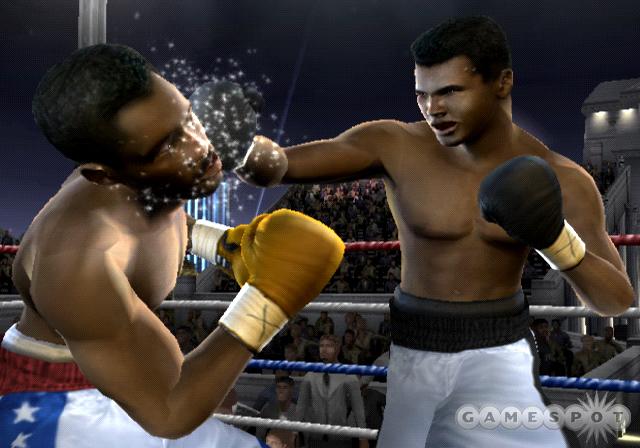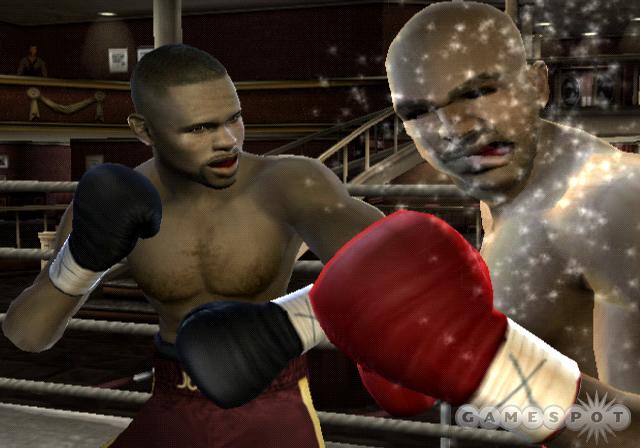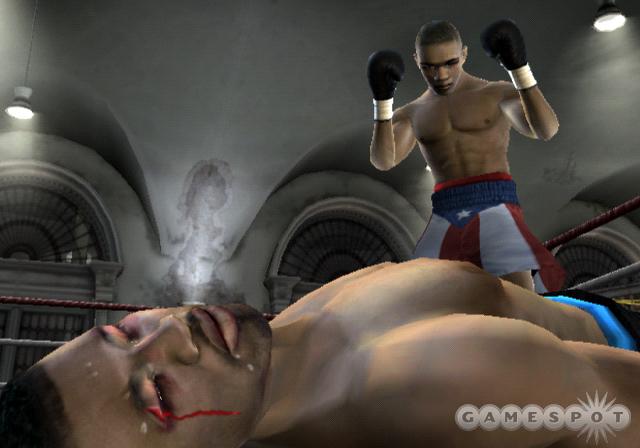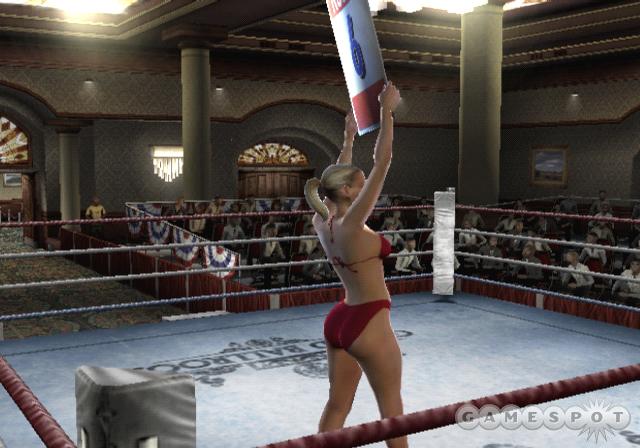Fight Night 2004 Designer Diary
We talk to EA Sports about its innovative upcoming boxing game.
The Genesis of Total Punch Control
By Kudo TsunodaExecutive Producer, EA Canada
Hey! My name is Kudo Tsunoda, and I am the executive producer on EA Sports Fight Night 2004.
One of the hardest things about working in the video game industry is trying to be creative under unyielding deadlines and pressure. Before getting into game development, coming up with fresh ideas for how you would change a specific game you were playing seemed much easier. Sit around playing games, and every once in a while some idea for how to improve a title would come. But continuously coming up with fresh ideas, by a specific date, means you really have to start using your brain at all times of the day. You don't really have the luxury of sitting around for days at a time waiting for ideas to come. This means that many of the cooler game ideas I have participated in have some weird story revolving around how they came to pass.

Fight Night 2004's Total Punch Control technology, much like other great inventions (laws of gravity, flux capacitor), came about as a result of a blunt impact to my skull. At the time, we were in our design phase for Fight Night 2004. We were playing nonstop boxing and fighting games as well as participating in boxing classes three days a week to try to learn the finer points of what makes certain boxers successful as opposed to others.
In the morning, we had a meeting with our design team to discuss high-level items of what we wanted to be our main gameplay focus and changes from other boxing and fighting games we had played. One thing we all agreed on was that the way other games had handled the act of punching gave you no sensation of actually throwing punches. Each product we looked at had the same basic mechanic for punching: You hit a button and a punch animation plays. You had no control over your fists. Brian Hayes, one of our assistant producers, has been an amateur boxer for several years and started talking about how this complete lack of control of your fists was the core problem of every game he had been playing. We started talking about some potential ideas, but nothing really got settled.
The meeting had to break, as it was time for our afternoon boxing class. During the class, Brian and I happened to get matched up for a sparring session. Now, understanding that Brian is a much superior boxer to me, he decided to use that opportunity to start explaining some of his design ideas to me in a real-life situation. First he started with the importance of defense and why that is critical to any boxer's physical health. While the class was mostly noncontact, Brian started firing punches directly into the middle of my face. The way he was throwing punches, I am fairly certain he had some built-up issues from my not listening closely enough to his design ideas in the morning meeting.
At that point, the need to start using some defense became quite apparent. It only takes a few shots to the face to make that painfully clear. So he started teaching me about how boxers actually set up their punches by setting me up for some clean shots of his own.

First he started showing me how much difference it makes when you only have a few set punches that must be thrown to completion once they start. He was simulating what it is like to throw punches with the buttons. Once a punch starts, you cannot stop it. It just goes in the same pattern the exact same way. Once I picked up those patterns, punches became easy to block. This type of mechanic made for extremely boring gameplay in every other game. Landing punches meant that you had to throw as many punches as fast as you could. There really was no skill to it at all--total button-mashing gameplay. You could really see this in the reviews of other boxing games: "Extremely repetitive gameplay," "I fought (3) fights and then there was nothing new to entertain me," "Complete non-skill-based gameplay." This is something we needed to change for Fight Night 2004.
Once I started blocking Brian's incoming punches, he started using his superior control of his fists to drill me in the head repeatedly again. Instead of just throwing the punches, he started faking punches with his fists, throwing punches and then pulling them back. He got me to commit to blocking an incoming punch in a specific area, then would not extend on that punch and instead would land a shot to an open spot on my head or body. Since I certainly am averse to getting punched, I would react repeatedly to the first or second incoming punch, and he would trick me every time. This kind of mental warfare, setting up the punches and getting your opponent to believe a punch is coming when it is not, is what separates the good boxers from the great ones. Much like in a batter/pitcher battle, there are a lot of mind games that go on. This type of intense head-to-head warfare is what makes sports games and multiplayer games so much fun.
At this point, having gotten pretty battered and bruised, I started to get pretty pissed. Being somewhat larger than Brian, I forgot that I was in a boxing class and just started to try to smack him as hard as I could. So Brian switched to counterpunching--blocking or leaning out of the way of my punches and hitting me when I was completely vulnerable. Fortunately, the sparring session came to an end as I was getting my ass kicked. But as the last few punches landed squarely on my head, I started to really understand what Brian was talking about and how having total control over your fists in boxing was critical to fun, skill-based gameplay.
We excitedly all piled in a room, fresh from our boxing class, still in our workout clothes with hands wrapped and people's faces covered in sweat and bruises. We hammered out the details for Total Punch Control and the basic gameplay mechanics for Fight Night 2004 in a long afternoon and evening design session.

It was obvious from that point on that the punches had to be thrown with the analog sticks. We have made the analog sticks an extension of your fists. You can now control your fists onscreen with analog movements instead of button presses. Instead of having to throw whole punch animations with a button press, you can now have total control of your fists. When you move the analog stick, you see your fist making those same movements onscreen. In order to throw a punch, you make the same motion with the analog stick that you would make with your fists in real life. You can now fake punches by starting to make a punch motion with the analog stick and then pulling it back and punching quickly to a different location--just like Brian was doing to me in boxing class. The control you have over your fists and punching is unprecedented in any boxing or fighting game.
In Fight Night 2004, the Total Punch Control technology is also being used to implement an extremely fast and responsive blocking scheme. Where before you pressed a block button, which gave you a very generic block pose, you can now use the analog control of your fists to quickly pick off incoming punches. As you see punches coming in, just use the analog stick to move your fists into the way of the punch. You can block it with your fists, arms, and elbows just like real boxers.
You also have total analog control of your upper body. The left analog stick is used to move your boxer around the ring. By holding in the left trigger, it plants your feet and turns the left analog stick into an extension of your upper body. Any way you can move the left analog stick, you can move your upper body. This gives you the ability to easily lean out of the way of punches. You also have full 360-degree rotational control of your body. This means you can bob and weave to avoid combinations or just to keep your head moving, making it a hard target to hit. This also allows you to confuse your opponents with your upper-body movement so they have no idea where your next punch is coming from.

Looking back, it all seems so simple now. So much has been added to the game that other boxing and fighting games have sorely, sorely missed. Total control of your fists. Quick and responsive blocking. Full upper-body control. Skill-based gameplay--the complete elimination of mindless button-mashing gameplay. Not sure why any other game has not done this before. I have no idea why it took a savage beating from Brian Hayes to pound the importance of these items home to me. But it's easy to understand how much fun having these elements in the game is as soon as you pick up the controller. This is like no other boxing or fighting game you have ever played. It's the ultimate head-to-head competition.
Plus, now that I can control my fists and counterpunch in Fight Night 2004 like I am no way able to in real life, I am able to exact some semblance of revenge on Brian when we play the game. It is nice to see his face getting pounded in for a change. It is a sensation I highly recommend checking out.
The game is EA Sports Fight Night 2004 for the PS2 and Xbox. It will be in stores in March. Check it out! I hope you have as much fun playing it as we had making it!
Got a news tip or want to contact us directly? Email news@gamespot.com
Join the conversation